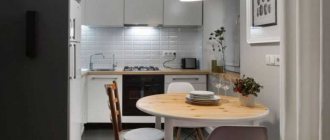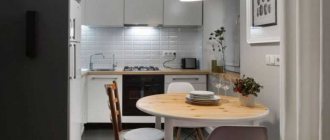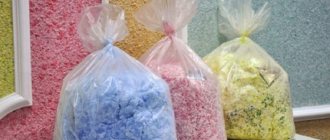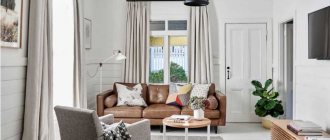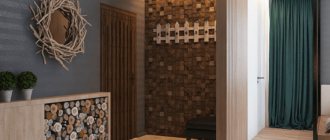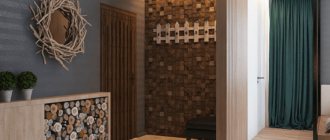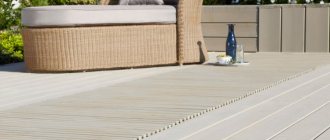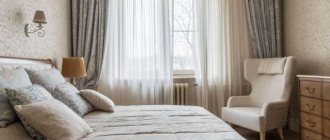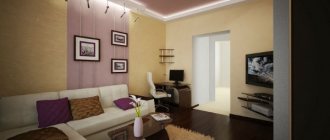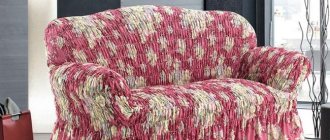Requirements for wallpaper material
Today, a variety of materials are used to create wallpaper (textiles, paper, liquid base), but they all must meet the following requirements:
- Safety for humans. The material used to create wallpaper must not contain harmful or toxic impurities.
- Strength. A fragile canvas on the wall can easily be damaged, this issue is especially relevant for children's playrooms.
- Resistance to moisture and temperature changes.
- Possibility of cleaning (if possible, wet cleaning).
It is also worth noting the design of the wallpaper in the apartment and the cost of the material.
Combination
Combining monochromatic structures is most suitable for people who prefer a simple and unpretentious design. This option is suitable for lovers of interior decor and paintings.
A good solution would be the following combination: one coating is plain, the second has the same shade, but with an ornament. Such kits are often offered in building materials stores.
Horizontal combination is used mainly to visually enlarge the room.
- This can be done by using entire canvases of wallpaper that have different shades - for example, light and darker.
- In this case, light-colored coatings are placed in the upper part, and they occupy approximately 70% of the total wall area.
- Another way to combine wallpaper is with horizontal stripes. Here, special attention should be paid to the height of the ceiling - the higher it is, the wider the strip.
- In order for the ceiling to appear visually higher, it is worth using a vertical combination.
- In this case, the following rules must be observed: the width of stripes of different colors must be the same.
- It is advisable to stick the canvases on the wall at intervals of one or two stripes, and their texture should be identical to the main coating.
- It is quite acceptable to use stripes that contrast with the main color or have a bright small print.
- In large rooms, you can use the following method: distribute the main color over the entire wall area, and highlight the corners with contrasting vertical panels or stripes.
The most labor-intensive, but very effective way to decorate a room is using patchwork techniques. It's about the same as putting together a puzzle or mosaic. Moreover, the elements can be glued to the main coating either overlapping or end-to-end.
When decorating a room using this method, the picture should be in front of your eyes on paper, in the form of a sketch, and not in your head.
There are rooms decorated using 3D technology. Most often it is used to visually enlarge the space and give it a sense of reality. It should be noted that this is one of the most expensive ways to decorate premises.
Selecting wallpaper
Today in building materials stores you can find the following modern wallpaper for apartments:
- Paper wallpaper.
- Non-woven wallpaper.
- Vinyl options.
- Acrylic wallpaper models.
- Textile based wallpaper.
- Metallized coating.
- Bamboo wallpaper.
- Cork models.
- Liquid wallpaper.
- Photo wallpaper and wallpaper with 3D effect.
- Fiberglass based wallpaper.
Each of the presented options has a rich decor and a number of advantages and disadvantages in practical use.
The texture, relief and cost also differ. Therefore, before purchasing finishing materials, you should definitely calculate the required number of rolls or liquid base, and also preliminarily evaluate photos of wallpaper in catalogs from manufacturers.
Popular design mistakes
Wallpaper plays an important role in apartment interiors, because the wall surface area is quite large. The overall impression of the room will depend on the choice of wallpaper design. If you make a mistake, the room can become dark and gloomy, or even tiresomely bright, and the abundance of stripes or small patterns will dazzle the eyes, and the room will visually become more cramped. To avoid mistakes, it is important to study the main rules for choosing wallpaper, colors and textures.
Types and features of wallpaper
Modern wallpaper for your apartment provides plenty of space to bring any design ideas to life. They differ in price, color, texture and quality. When choosing wallpaper, it is first important to determine your financial capabilities and the degree of safety and environmental friendliness.
Once you have decided on the type of wallpaper, you can move on to a selection based on style, patterns and colors.
- Paper wallpaper is the most budget option, which can be divided into 2 types (single-layer and double-layer), and there are also wallpapers with a matte or glossy finish. paper wallpaper is not resistant to abrasion, and also does not tolerate wet cleaning. But you can quickly re-glue them without causing significant damage to the family budget, making them indispensable for a child’s room. In addition, this is a completely environmentally friendly material, so you can rest assured about the health of your children. Light and narrow rolls are easy to paste, and such repairs can be done “with one hand.”
- Vinyl wallpaper is stronger than non-woven wallpaper, is resistant to abrasion, is not afraid of moisture, and will last for many years. But formaldehyde in the wallpaper can be released into the air, which means it is better not to glue such wallpaper in the bedroom and nursery.
- Non-woven wallpaper is a modern alternative to paper canvases. They will give you more choice. Complex texture, unusual colors and prints, combined with a high degree of environmental friendliness, will make such canvases indispensable when decorating walls. non-woven wallpaper is glued end-to-end, and the glue is applied directly to the walls. The large roll width makes it possible to reduce the number of joints, but it is better to glue such wallpaper together.
- Paper-based photo wallpapers make it possible to create unusual accents when decorating. A variety of different themes will give you the opportunity to choose effective decor for any room, be it a hall, a nursery or a bedroom.
- Textile wallpapers are premium-class canvases that make it possible to create surfaces that are pleasant to the touch on the walls. Noble colors and exquisite designs help emphasize the status and taste of the apartment owners. gluing textile wallpaper requires high skill and accuracy, so it is better to entrust this task to professionals.
How to combine wallpaper?
The principle of combining wallpaper
The design of a living room in an apartment using combined wallpaper has become quite popular, and several types of combinations are distinguished:
- Combining plain wallpaper with stripes/patterns in a single color scheme.
- Combining canvases with different degrees of color saturation in one range of colors, or a gradient color transition/use of 3-4 textures in different colors.
- Combining wallpaper with different patterns, including the implementation of patchwork techniques.
It is worth learning how to correctly combine colors with each other.
How to combine colors
It’s not as easy to combine wallpaper in an apartment as it might seem at first. To do this, it is worth remembering that there should be no more than 4 colors in one room, otherwise you will end up with a “vinaigrette” of colors.
When combining, you should use a color wheel and stick to one of the combination methods. You can choose the following colors:
- Coplanar - combine adjacent shades in the color wheel.
- Complementary - when decorating a room, they combine colors that are located on opposite sides of the color wheel, and with this combination, contrasting, interesting interiors are obtained.
- Monochrome - there is one main color in the room, only its saturation can change.
It is difficult to combine wallpapers of different colors and textures, because this requires experience and artistic taste; stores often offer ready-made solutions (paired wallpapers, i.e., one-color and with a beautiful pattern in the same range of colors). When purchasing, it is important to pay attention to the batch number that is on each roll, because products from different batches may differ slightly from each other.
Preparation for gluing
Before gluing wallpaper in an apartment, it is worth cleaning the surfaces of the walls from the previous coating, and also leveling the surfaces as much as possible. Old paper-based wallpaper is removed using a spatula, spraying hot water on the surface. If the walls have been treated with whitewash, it should be washed away and the paint sanded to improve the adhesion of the surfaces. All holes and cracks that remain from fixing the paintings and the rest must be puttied. Small wall unevenness can be compensated for using dense canvases. Vinyl and non-woven wallpaper hide problem areas much better than thin paper wallpaper. In this case, the surface for finishing with wallpaper should be perfectly smooth, without roughness and not crumble. Increasingly, before gluing, the wall covering is treated with a special primer, which creates microfilms on the surface and saves wallpaper glue, preventing it from sticking into the walls.
Noise insulation
In city apartments, the issue of sound insulation is acute, and you can try to hide from outside noise or try to protect yourself from the noise of your neighbors if there are barking dogs in the apartment, small children or the owners like to listen to music at full volume. Naturally, nothing will drown out the sound of a hammer drill, but you can ensure that you do not hear the crying of your neighbors’ children or a neighbor’s quarrel. Some types of wallpaper such as non-woven and vinyl will provide some noise insulation. Due to the high degree of density and artificial turf, they will create a low sound barrier. Naturally, wallpaper alone cannot solve a serious noise problem.
There are special soundproofing options for any wallpaper design in the apartment.
- The non-woven backing levels the walls, perfectly allows moisture and steam to pass through, maintaining an optimal level of humidity in the room, and also has an average degree of sound insulation.
- The paper backing is an environmentally friendly material, but it does more to level the surfaces and make their tone uniform than to soundproof.
- Cork backing is the best option for thermal and sound insulation, and the breathable, environmentally friendly material can even be used in children's rooms. Different thicknesses make it possible to choose the required level of sound insulation to suit your conditions.
- The polyethylene foam backing has high sound insulation characteristics and also plays the role of insulation. The disadvantage is that such material does not “breathe”, which is why moisture will not be removed from the room.
Paper wallpaper in the apartment
They are distinguished by rich decor, a huge selection of colors and patterns. The advantage is the affordable price and ease of repair.
However, the paper base is not resistant to moisture, breaks easily, and often requires replacement after children's drawings, dirt, or the surface gets wet.
Note!
- Wallpaper glue - 155 photos of the best compositions. Review of manufacturers and the best glue brands
Wallpaper from Leroy Merlin: 180 photo examples and video master class on the use of different types of wallpaper
Wallpaper for the kitchen - types, types, designs and expert advice on choosing a design (165 photos + video)
Non-woven wallpaper
This type of wallpaper is easy to glue and easy to remove if repair work is necessary. The glue is applied only to the wall, and the relief structure of the material allows you to hide imperfections and unevenness on the wall.
The cost of the material is higher than for classic paper wallpaper. The advantage is the fact that some types of non-woven fabric are excellent for subsequent painting.
Vinyl wallpaper in the interior
One of the most durable types of decorative coating among modern wallpapers. Particular strength is achieved through two layers - PVC and paper, non-woven.
Vinyl coatings are moisture resistant and resistant to mechanical damage. Rich relief and pattern allow you to give the room a special interior style.
Disputes in the design community arise over the only drawback - poor environmental performance.
Compatibility assessment criteria
When choosing materials for finishing walls in a room, pay attention to the following parameters:
Color To assess the harmonious combination of different shades, you can use the color wheel diagram. An elegant classic interior suggests options for gluing adjacent tones, and for decorating rooms in a shocking pop art style, preference should be given to contrasting colors.
Use a color wheel chart
Texture When using canvases with different textures for walls, it is advisable to choose the same shade. In this case, the difference in the surface finish of the material will be more noticeable.
Decor In order for the design of the stickers to be harmonious, their decorative design must be combined in color and style. A composition of smooth plain and patterned fabrics looks good. Combining bright colors with vertical and horizontal patterns is undesirable, since this decorative option is perceived negatively.
Among the popular options is decorating walls with wallpaper of the same color, but in different shades. Graduated canvases in peach, beige, coral or dark blue tones can be placed both horizontally and vertically.
Graduated horizontal panels
They go well with plain ones and with patterns in the form of wide or narrow stripes. This decor visually increases the height of the ceiling and creates the effect of a more spacious room.
Increasing the ceiling height due to vertical stripes
Textile based wallpaper
Textile models are distinguished by rich patterns and colors, relatively high cost of material and difficulties in maintenance.
It is absolutely not recommended to use such wallpaper for decorating children's rooms or dining areas. The structure is soft and susceptible to damage and may require immediate repairs.
Metallized canvas in the interior
The manufacturing technology of this type of wallpaper involves applying aluminum coating to a fabric base.
The next layer is paint and the original ornament. Due to its durable multilayer structure, the coating is heavy and resistant to moisture.
Note!
- Types of wallpaper: features, pros and cons of wallpaper types. Classification by texture, number of layers, drawing (photo + video)
- Wallpaper for the bedroom: TOP 140 photos and video reviews of bedroom designs with wallpaper. Suitable styles, colors and patterns of wallpaper for the bedroom, choice of materials
Gray wallpaper: features of using gray wallpaper. The choice of furniture, decoration and lighting for gray wallpaper. Photo and video design ideas
Since wallpaper has a high price, metallized canvas is often used as a relief insert against the background of vinyl or paper wallpaper.
Wallpaper made from natural materials
This group of finishing materials includes bamboo and cork wallpaper.
The material used for production is natural, environmentally friendly. Due to the complexity of producing decorative coatings, wallpaper has a very high cost.
However, due to the porous structure, they allow air to pass through well, preventing fungus from developing on the underlying wall.
Liquid wallpaper for home
The main advantages of using this group of finishing materials are:
- Easy to apply.
- The wallpaper on the walls does not form joints.
- Hiding unevenness and construction defects.
- Strength.
- Affordable price.
- Rich decor.
- Moisture resistant.
The mixture is diluted according to the attached instructions, immediately before application to the wall.
Choosing wallpaper for living rooms
The choice of a specific wallpaper model depends on the purpose of the room, the temperature climate in the room, the chosen interior style and the personal wishes of the owner.
Wallpaper of various types is often combined with each other, and original inserts are created using photo wallpaper or 3D models.
Various wallpapering options are used to visually expand space or zoning a room. Don’t forget also about the color scheme of the material for different rooms.
The combination of wallpaper colors in the interior
It is not clear whether the sense of taste can be instilled or whether it is formed before conscious age. For some people, questions about combining colors in the interior come easily and naturally, while others need theory.
Bright wallpaper in the interior
Good visual examples of wallpaper compatibility in color, pattern and texture are wallpaper collections. Manufacturers produce ready-made matching sets of several background and accent wallpapers. And we must give them credit, the wallpapers within one collection really go well together:
As you can see from the photo, color is just one of the ways to combine wallpaper. The wallpapers within the collection do not match because their colors match. It's about the pattern, texture and most importantly color saturation
We have already written in detail about the importance of saturation in combining colors in the interior; all this also works for combining wallpaper
These simple combinations work with other colors too:
Because The wallpaper is glued to the wall using tubes, there is no problem joining them on the same wall. In this case, the issue of compatibility is especially relevant. Photo examples:
Calm wallpaper in neutral colors
The main thing is not to forget that the walls are just a background. Many people make the mistake of choosing wallpaper colors that are too bright. Often this happens because during planning we imagine the future room, and we want it to be bright. At the same time, we do not take into account that in real life the apartment looks completely different from the one in the drawings or photos only after renovation. The rooms have furniture, things, appliances, curtains, etc. and all of this also has its own colors. If the walls are also bright, it can turn out to be a mess. One bright wall is almost always a good idea. More is already a risk.
Wallpaper can be accentuated not because of its color, but because of its interesting texture. Here, for example, is wallpaper made of mica (fine sand). The photo doesn’t show it very well, but in reality it’s quite an accent:
In modern design, monochromatic wallpapers are in fashion, which simply act as a replacement for paint.
They do not make any accents and do not attract attention at all. And here is photo evidence that this is a completely interesting and not boring option.
Let's summarize the 7 basic principles:
If we are looking for budget wallpaper, then only one-color wallpaper without designs or patterns. We cover most of the wall area with calm background wallpaper, and one or two walls with bright accent wallpaper. We choose as an accent wall the least loaded with other objects, located on the axis of symmetry. You can understand the principles of wallpaper compatibility by viewing ready-made collections. The same theory applies to the combination of wallpaper colors as for any other materials.
Pay attention to saturation. Basic background colors with a minimal chance of making mistakes are white and gray. Wallpaper doesn't have to be the center of attention. It is quite possible that for your style you need to choose the most neutral options, and add some zest with something else.
We almost forgot: photographs very poorly convey the appearance of the wallpaper; you always need to look at them live. We hope our theory was useful to you, good luck with the repair!
Save and share - it will come in handy!
Choosing wallpaper for the living room
When carrying out renovations, the greatest attention is paid to this particular room - a meeting place for guests, family gatherings and festive evenings.
The color scheme is selected only according to the owner’s preferences; only too poisonous and harsh shades are excluded. An excellent solution would be to use photo wallpaper for the living room or embossed wallpaper with a 3D effect.
Original inserts made of metallized fabric allow you to decorate the living room interior in the latest trends of modern design.
How to combine wallpaper in the living room
- Wallpaper can be purchased according to type: Wallpaper that is original in color is easiest to combine. Today they are presented in a colossal assortment, so choosing a typical combination will not be a problem. Experienced designers prefer to work with similar shades, but when an unusual effect is needed, they play with sharp contrast. In the latter case, combining different types of wallpaper in the living room
helps make the room not just bright, but also interesting. You can also combine the finish according to the pattern. Here, even if you use wallpaper of the same tones, a specialist will create the necessary comfort for a family vacation. In this case, first of all, one tone is selected on which the original patterns will be applied. This move will allow you to choose an interesting living room interior without spending much effort. For example, flowing stripes or large flowers may appear between monochromatic stripes, which will become a wonderful decorative option. But working with texture is considered the most difficult technique. However, you can use a combination of paper duplex with vinyl wallpaper. They are purchased in one tone. The subtlety is that after pasting, the texture of vinyl wallpaper will add a very interesting feature to the interior: the walls in some places will acquire volume, and this will give the interior a non-standard flair. - The joints of wallpaper sheets can be additionally finished with zigzag stripes or waves. However, it is difficult to do this on your own: performing such finishing requires certain skills.
Textured wallpaper creates the illusion of a back wall
Combining wallpaper horizontally
This principle is well known to everyone, since it is used to decorate walls in schools and medical hospitals. Don't be alarmed by using a combination of wallpaper of this type in the living room
will make her charming and there will not be even a hint of formality left in the room. Pasting is carried out in a horizontal plane, so a transverse junction of two strips will appear on the wall, located approximately in the middle of the height. You can also “play” with it and highlight it in an ornate way. There can be more than two such stripes, however, the presence of them in large quantities can give the wall a too motley appearance. A bright pattern on the walls will result from a combination of contrasts. If you want to get a peaceful atmosphere in the room, there is a reason to experiment not with the color spectrum, but with texture, while adhering to the rule of similarity of shades.
Horizontal combination of striped wallpaper
Combining vertically
With this type of wallpaper combination in the living room
use the same principles as with the previous, horizontal one.
The stripes may differ in width and alternate in color or texture sequence. The vertical combination gives the effect of ceiling height and allows you to brighten the shadowed areas of the room
.
Color-rich vertical stripe wallpaper
Combining flaps
This type of decor is somewhat similar to folding a mosaic. In this option, multi-colored or multi-textured pieces of wallpaper are glued to the wall in a certain order.
Before you start implementing a bold idea, you need to take a critical look at how the purchased wallpapers fit together. Lay them out, combining them in the order in which you are going to place them on the wall; If everything is harmonious, you can begin work. Patchwork combination does not limit imagination, and for this all designers appreciate it.
From pieces of wallpaper you can create panels of unique beauty.
Chaotic combination of wallpaper in the living room
Wallpaper inserts
The method of wallpaper inserts is a type of patchwork combination, only in this case very large pieces are used and their edges are trimmed. This method is good for zoning or highlighting a certain area of the room. Good use of inserts in a turquoise living room
. Contrasting pieces limited by moldings or frames are attached to the main background. This technique is often used when creating the Baroque style. A special style includes combinations with photo wallpaper. There are entire collections of these wonderful inserts on sale.
Inserting textured wallpaper to make the living room unique
“It is wrong to consider wall decoration a purely decorative nuance, the purpose of which is to attract attention. If an experienced designer is involved in a project, the first thing he does is change all the principles.”
Choosing wallpaper for the bedroom
The main principles for choosing a coating are safety, quality, and natural shades. For an adult bedroom, you can choose paper, vinyl, or non-woven wallpaper.
An acrylic canvas made in calm warm colors with a geometric pattern is perfect.
What types of wallpaper are there?
Below we will take a closer look at the decorative properties of materials intended for walls, since basically they determine the style of the interior of your apartment and give the room integrity.
Paper wallpaper
The most common type. Made from natural material, due to which the walls can “breathe”. Paper wallpapers come in both single-layer (simplex) and two-layer (duplex).
Paper wallpaper as the most economical finishing option
It is worth considering: before pasting simplex, you must carefully prepare the walls, since flaws will be visible. They also have low strength and cannot be washed with water. As for duplex wallpaper, their relief is more convex, which allows you to hide minor defects in the walls. In addition, they are highly durable, have moisture-resistant and sound-absorbing properties.
Vinyl wallpapers
They are good for use in the kitchen, hallway and bathrooms, since they are waterproof and durable, they are not afraid of direct sunlight. Such wallpaper is impregnated with solutions that prevent the formation of fungi and mold. Thanks to the richness of textures, they can imitate any coating: wood panels, leather or marble. The main disadvantage is poor breathability.
Vinyl wallpaper is the most common type of coating
Therefore, they have now begun to produce a type with micropores, which allows the walls to “breathe”. There are four types of vinyl coverings: silkscreen, foamed vinyl, hard and smooth.
- Silk-screen printing - this type of wallpaper consists of two layers: paper and pure vinyl or vinyl with silk threads. They have high strength and are easy to clean.
- Foamed vinyl (or structural) hides wall imperfections well. With this type of wallpaper you can create the effect of relief plaster.
- Hard vinyl - resistant to mechanical stress and damage.
- Smooth vinyl (or flat, self-leveling) is similar to hard vinyl. But unlike the latter, it is smooth and less dense.
- Silkscreen printing
- Foamed
- Solid
- Smooth
Vinyl wallpaper on non-woven backing comes in different types
Acrylic wallpaper
They consist of two layers: top (polymer), bottom (paper). Compared to vinyl, they do not have sufficient water-wear resistance.
Acrylic wallpaper with a large pattern in the hallway
Therefore, you should refrain from pasting them in the bathroom and kitchen.
Wallpaper for painting
Vinyl on paper or non-woven backing is durable and can hide wall defects. The advantage of structural wallpaper: the ability to repaint walls many times without losing texture. Non-woven wallpaper is practical and durable. They acquire special strength after painting.
Can be repainted any color at least every year
Wallpaper of this type can withstand up to five paintings. The main advantage is that they do not need to be lubricated with glue. It is enough to lubricate only the walls.
Textile wallpaper
They are made by gluing fabrics onto a paper, non-woven, foam or vinyl base. They are soundproof and have good thermal insulation. There are also disadvantages: they are not resistant to mechanical damage, do not “tolerate” wet cleaning, and absorb odors and dust.
One of the most expensive types of wallpaper, it looks very “rich”
By the way, before pasting it is necessary to carefully prepare the walls, smooth out all the irregularities and putty them with at least one layer of putty.
Fiberglass or fiberglass wallpaper
This type can be washed, rubbed with brushes and cleaning agents - the surface is impregnated with a water-repellent composition. In addition, they do not collect dust and are difficult to ignite. They can be repainted up to 12 times without losing the relief or design.
Fiberglass wallpaper for painting
True, otherwise this type of wallpaper is used for public spaces.
Cork wallpaper
Made from balsa wood, they have antibacterial, thermal insulation and waterproofing properties. You should avoid using them in the bathroom and kitchen.
Choosing wallpaper for the hallway
Wallpaper in the hallway should be characterized by increased strength, resistance to moisture, and ease of maintenance. The best options would be vinyl wallpaper, metallic fabric, liquid wallpaper in the apartment.
The modern building materials market offers its customers a huge range of decorative coating products.
New wallpaper designs for 2021, presented in official catalogs from manufacturers and designers, will help every master make the best choice.
Using two types of wallpaper in different rooms
How to combine two types of wallpaper in different rooms? To create a harmonious interior, you need to take into account the purpose of the room, its dimensions and design style.
Consider the dimensions and design style for different rooms
Usually the largest room is the living room, which sometimes serves as a dining room and relaxation area for all family members.
Bright living room for relaxing with family
In some cases, there is a workplace or a corner for pursuing your hobbies. Using vertical division, you can use wallpaper to highlight functional areas.
Create a corner for your favorite hobbies
The bedroom is a place for sleep and relaxation, so its interior is most often designed in calm colors. To decorate the room, use wallpaper with an unobtrusive pattern in pastel colors or combine plain canvases with a bright accent on one of the walls in the form of an image or a spot of color.
Calm colors in the bedroom
The kitchen is a room with special conditions. High humidity and temperature negatively affect finishing materials, and there is a high probability of contamination.
Pasting walls with combined wallpaper in the kitchen
Therefore, when choosing wallpaper for the kitchen, you need to pay attention not only to the decor, but also to the properties of the paintings.
Choose moisture-resistant linens for your kitchen
They should not fade or crumble. In some cases, you can combine regular and washable wallpaper for different walls. The color scheme of the finish is selected taking into account the furniture and style of the room.
